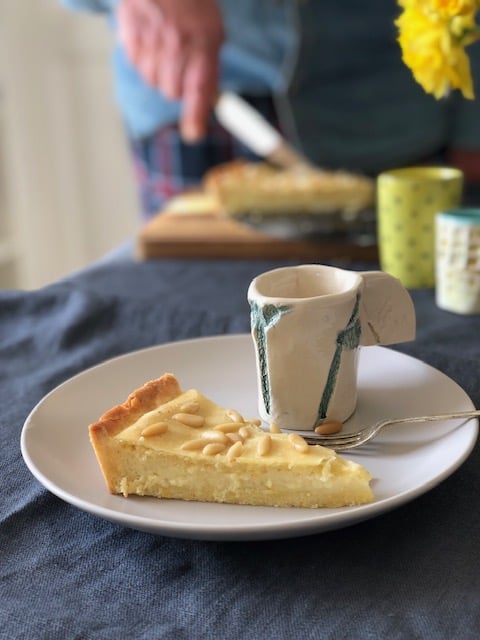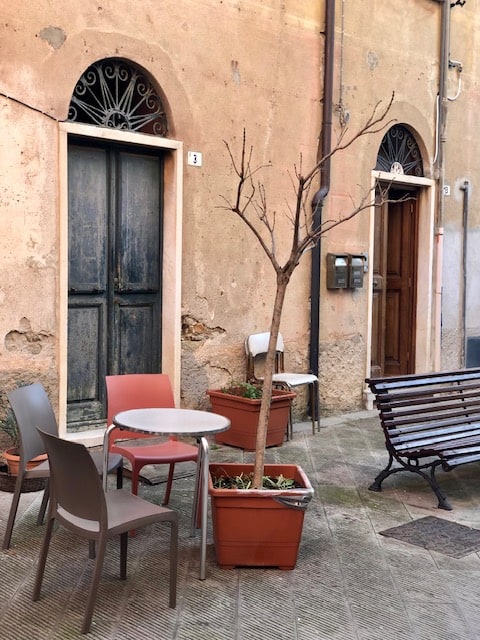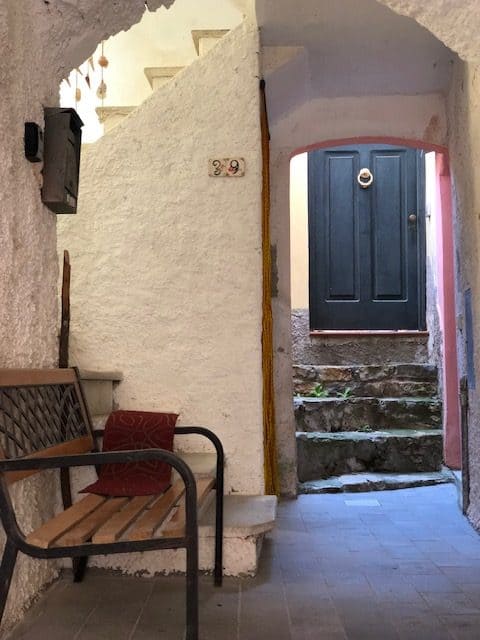
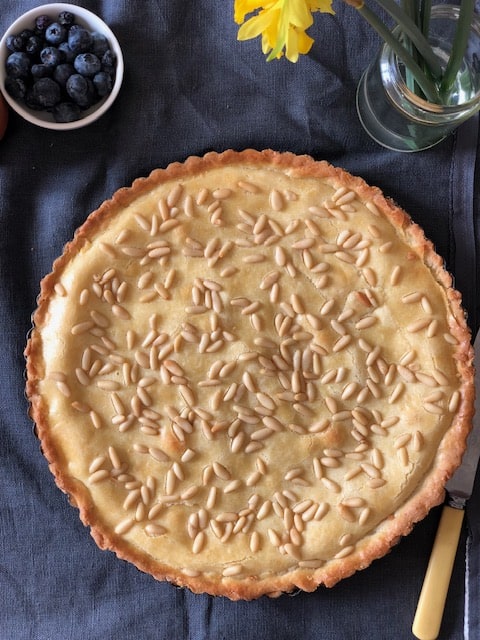
Torta della nonna is a gorgeous rustic tart made from two simple Italian classics: pasta frolla and crema pasticcera. Put together this looks like : lemony pastry cream sandwiched between two layers of crumbly, sweet shortcrust pastry, covered in pine nuts, and baked. It tastes like : heaven.
The name torta della nonna, literally “grandma’s cake” is a bit of a misnomer, but a clever one . The tart is said to have been invented by the Florentine chef Guido Samorini in the 1900s, after his customers complained about the same old, same old desserts he’d on offer to which Guido responded by whipping up a simple, rustic tart that he dubbed, torta della nonna.
The modest looking, but high-on-taste dessert, was a hit from the get-go, but, it strikes me that the naming of the tart, was also a killer move on Guido’s part. Does anything I wonder, have more pulling-power than a granny reference when it comes to the Italian kitchen? Guido surely sealed the deal for his tart’s popularity both then, and through the ages, with that emotional word association, torta della “nonna” …. smooth work Guido! I like it!!
To make this dessert takes time as several stages are involved. That said, it’s time well spent as once you’ve mastered sweet pastry (pasta frolla) and smooth custardy cream (crema pasticcera), there’s no limit to the number of times you will use them in other projects too.
When it comes to the pastry, for this tart I double my standard, sweet pastry recipe even though, the tart needs only about 1.5 the quantity. I do this because the recipe seems just right as it is, and I don’t fancy mucking around altering egg-to-other ingredients ratios with half measures. Also, I just find it easier to make double pastry and to have a little extra wiggle room. Leftovers can quickly be made into a few biccies to have on the side or tossed into the freezer for a future project.
For the crema, the quantity is on the generous side too, but again, an extra spoonful can be enjoyed with something else (or eaten as you work). The main thing is to fill the tart so that the pastry “lid” is at even height with the top of the tart tin (a low-tide tart is a little sad, no?). I tend to make torta della nonna in my loose bottom, 26cm tart tin with sides a little over 2.5cm, but sometimes I opt for a deeper dish, so having a little extra crema is welcome.
Once out of the oven, the tart is typically coated with a heavy dusting of icing sugar before serving. I don’t know what “nonna” would say, but I kinda prefer the tart nude, undressed, and golden on top.
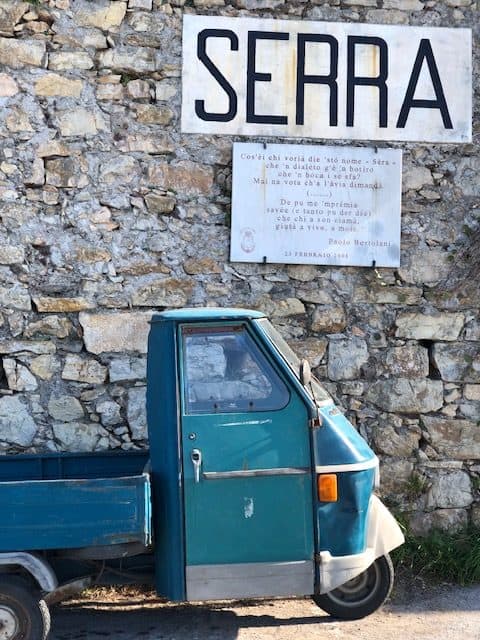
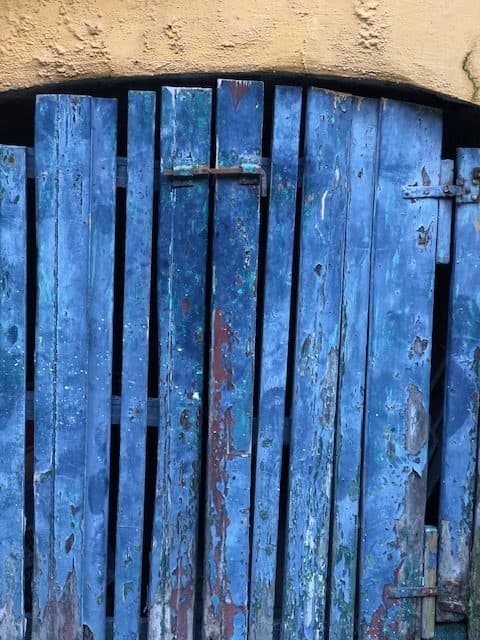
Torta della Nonna
* The way I have written the recipe below is to start with the pastry then, while it is resting, make the custard. Then, while the custard is cooling, return to rolling out the pasty, baking it blind, then, baking both the pastry and custard together. Both the pastry and the custard cream can be made in advance however, in which case, it’s just an assembly job, so skip to that part of the recipe. I hope it doesn’t look too confusing.
Sweet Shortcrust Pastry ~ Pasta Frolla (more than enough – there will be leftovers)
- 250g cold unsalted butter, chopped into small pieces
- 500g plain flour
- 160g sugar
- 2 whole eggs, plus 2 egg yolks, beaten
- Zest of 2 lemons
Custard Cream ~ Crema Pasticcera * adapted from Marcella Hazan
- 6 egg yolks
- 185g icing sugar
- 60g flour
- 750ml milk
- zest of 1 large lemon, plus a few strips of lemon peel (to taste)
- 1 teaspoon vanilla (or more to taste)
For the tart
- 50g pine nuts
- a little milk for brushing
- icing sugar for serving (optional)
To make the pastry: Place the butter pieces, flour and sugar in a food processor and pulse until you have a crumbly, sandy texture (no obvious butter chunks remaining). If mixing by hand, rub the butter into the flour and sugar. Add the beaten eggs and egg yolk, plus the lemon zest and pulse/mix again until the pastry just comes together into a smooth, elastic ball. Lightly flatten the pastry dough into a disk, wrap in plastic wrap and rest in the fridge for at least 30minutes.
To make the custard cream: In a heavy-bottomed saucepan but *off* the heat, combine the egg yolks and sugar until they become pale yellow and creamy. Add the flour gradually, beating in 1 tablespoon at a time.
In another small saucepan, gently heat the milk, bringing it to the brink of boiling (the edge of the pan will be ringed with little bubbles).
Still off the heat, add the hot milk very slowly to the beaten egg yolks, stirring continuously to avoid any lumps forming.
Place the saucepan with the combined egg and milk mixture over a low heat. Cook for about 5 minutes stirring steadfastly with a wooden spoon or whisk. While the occasional bubble breaking through the surface is ok, don’t let the cream come to a boil. The custard cream is done when it clings to the spoon, coating it with medium density.
Remove the saucepan from the heat and place in a bowl or sink filled with ice water and stir for a few minutes. Mix in the vanilla, lemon zest along with the pieces of lemon peel. Stir a while longer until the cream cools.
**Note: the crema can be made ahead of time. In which case, transfer it to a steel or ceramic container, and press cling wrap against the surface of the cream, and refrigerate. Remove the piece of lemon peel before using.
To assemble the tart: Preheat the oven to 200ºdegrees. Lightly grease a 26cm, round tart tin.
Soak the pine nuts in cold water for 10 minutes, then drain. This will prevent them from burning in the oven.
Remove the pastry from the fridge. Cut off a piece around ¼ size of the total and set it aside as an “extra” (use it to make biscuits or toss in the freezer for another day). Take the remaining piece of pastry and divide into two pieces of roughly 2/3 and 1/3 the total.
Roll out the larger piece of pastry so that it is big enough to line the bottom and sides of your tart tin, with a little overhanging the upper edges (the overhang will help seal the tart later, so while you can neaten the edges a little, avoid trimming them all the way off).
Line the pastry case with baking paper and fill with pastry weights, or uncooked beans/rice. Place the tart tin on an oven tray (to catch any pieces of pastry that break away from the overhang) and bake blind for around 10mins. Remove the tray from the oven. Remove the beans and the baking paper and allow the pastry to cool.
Reduce the oven temperature to 180º C.
Fill the cooled pastry crust with the crema pasticcera.
Roll out the remaining dough to a about 2mm thick and place over the top of the tart. Using your fingers, gently seal the edges of the pastry lid with the sides. Try to avoid stretching the pastry too much as it will shrink a little as it continues to cook. Brush the top of the pastry with milk, and scatter over the drained pine nuts.
Bake for 40minutes, or until the top is golden brown.
When ready to serve, dust with icing sugar (if desired) and serve at room temp.
*Adapted from Marcella Hazan, (1992) Essentials of Italian Cooking: A Cookbook. Alfred A Knof Inc, New York
